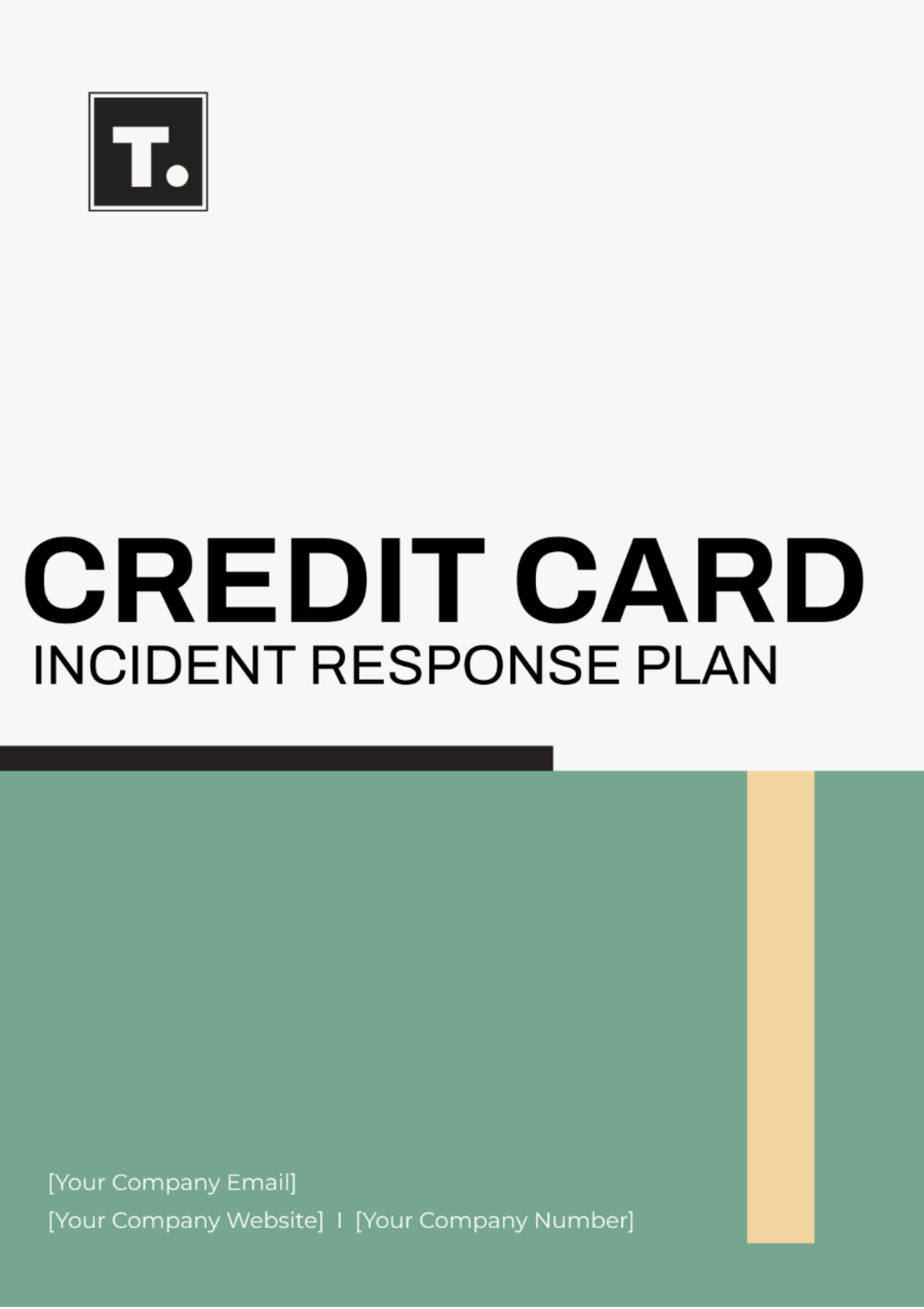Free Credit Card Incident Response Plan

_____________________________________________________________________________________
_____________________________________________________________________________________
I. Introduction
The Credit Card Incident Response Plan (CCIRP) outlines the procedures and protocols to be followed in the event of a security breach or incident involving credit card data at [Your Company Name]. This plan aims to minimize the impact of the incident, protect cardholder information, and ensure regulatory compliance with standards such as the Payment Card Industry Data Security Standard (PCI DSS).
_____________________________________________________________________________________
II. Roles and Responsibilities
Each member has specific roles and responsibilities as outlined below:
Roles | Responsibilities |
|---|---|
Incident Response Team | The Incident Response Team comprises individuals from various departments including cybersecurity, compliance, legal, IT, and finance at [Your Company Name]. |
Team Leader | Oversees the entire incident response process and coordinates communication between team members. |
Cybersecurity Experts | Responsible for detecting and analyzing security breaches or suspicious activities related to credit card data. |
Compliance Officers | Ensure that incident response actions align with regulatory requirements and industry standards. |
Legal Advisors | Guide on legal implications, contractual obligations, and communication strategies during and after an incident. |
IT Representatives | Assist in containing and remediating the incident, including restoring affected systems and implementing security measures. |
Finance Representatives | Assist in assessing financial impacts, coordinating with payment processors, and managing customer communications related to financial transactions. |
_____________________________________________________________________________________
III. Incident Detection and Reporting
Detection Methods
Utilize advanced threat detection tools, intrusion detection systems (IDS), and security information and event management (SIEM) systems to monitor and identify potential security incidents involving credit card data.
Reporting Procedures
Immediately report any detected incidents or suspicious activities to the Incident Response Team Leader and relevant stakeholders at [Your Company Name] through predefined communication channels.
_____________________________________________________________________________________
IV. Incident Response Procedures
Containment
Upon detection of a credit card data breach, isolate affected systems and networks to prevent further unauthorized access or data exfiltration.
Investigation
Conduct a thorough investigation to determine the scope and impact of the incident, including identifying the root cause and any vulnerabilities exploited.
Mitigation
Implement immediate measures to mitigate the impact of the incident, such as disabling compromised accounts, blocking suspicious IP addresses, and applying security patches.
Communication
Maintain transparent and timely communication with internal stakeholders, external partners, and affected parties throughout the incident response process.
_____________________________________________________________________________________
V. Communication Plan
Internal Communication
Notify key stakeholders within the organization, including executive management, legal, IT, and finance departments at [Your Company Name], about the incident and provide regular updates on response efforts.
External Communication
Coordinate with external parties such as payment processors, regulatory agencies, law enforcement, and affected customers to communicate the incident, its impact, and any necessary actions.
_____________________________________________________________________________________
VI. Recovery and Remediation
System Restoration
Restore affected systems and networks to normal operations using backup data and validated security configurations.
Post-Incident Review
Conduct a post-incident review to analyze the effectiveness of response actions taken, identify lessons learned, and implement corrective measures to prevent similar incidents in the future.
_____________________________________________________________________________________
VII. Documentation and Reporting
Documentation
Maintain detailed records of the incident, including incident reports, investigation findings, response actions taken, and communication logs.
Regulatory Reporting
Prepare and submit required incident reports to regulatory agencies by applicable laws and regulations.
_____________________________________________________________________________________
VIII. Compliance and Legal Considerations
PCI DSS Compliance
Ensure compliance with the Payment Card Industry Data Security Standard (PCI DSS) requirements related to incident response, reporting, and remediation.
Legal Obligations
Adhere to legal obligations such as data breach notification laws, contractual agreements with payment card networks, and privacy regulations governing the protection of cardholder information.
_____________________________________________________________________________________
IX. Conclusion
The Credit Card Incident Response Plan is a critical component of cybersecurity at [Your Company Name], providing a structured approach to effectively respond to and mitigate incidents involving credit card data. By following the procedures outlined in this plan, we can minimize the impact on our customers, protect their sensitive information, and maintain compliance with regulatory requirements. Continuous review and enhancement of the plan will ensure its effectiveness in addressing evolving threats and safeguarding [Your Company Name]'s reputation and trustworthiness.
_____________________________________________________________________________________
- 100% Customizable, free editor
- Access 1 Million+ Templates, photo’s & graphics
- Download or share as a template
- Click and replace photos, graphics, text, backgrounds
- Resize, crop, AI write & more
- Access advanced editor
Ensure your organization is prepared with Template.net's Credit Card Incident Response Plan Template. This fully customizable, editable template is designed for seamless use in our Ai Editor Tool, allowing you to tailor every detail to your needs. Stay ahead of incidents with a professional, adaptable response plan at your fingertips.
You may also like
- Birthday Greeting Card
- Wedding Card
- Engagement Card
- Invitation Card
- Background Card
- Teacher's Day Card
- New Year Card
- Save The Date Card
- Loyalty Card
- Valentine's Day Card Templates
- Mother's Day Card
- Greeting Card
- Eid Al Fitr Card
- Anniversary Card
- Farewell Card
- Thanksgiving Card
- Holiday Card
- Graduation Card
- Congratulations Card
- Father's Day Card
- Easter Card
- Get Well Soon Card
- Retirement Card
- Obituary Card
- Funeral Card
- Baby Shower Card
- Love Card
- Photo Card
- Game Card
- Baptism Card
- Funny Card
- Friendship Card
- Welcome Card
- Sympathy Card
- Good Luck Card
- Kids Card
- Bar Mitzvah Card
- Bridesmaid Card
- Change Of Address Card
- Cleaning Services Card
- Comment Card
- Encouragement Card
- Exam Card
- Folded Card
- Half Fold Card
- Hug Card
- Keep in Touch Card
- Library Card
- Loss Of Pet Card
- Membership Card
- Miss You Card
- Monopoly Card
- Name Card
- New Baby Card
- New Home Card
- Prayer Card
- Punch Card
- Raksha Bandhan Card
- Report Card
- Sorry Card
- Spa Card
- Sports Card
- Teacher Appreciation Card
- Tent Card
- Thinking of You Card
- Wedding Reception Card
- Wedding Advice Card
- Appointment Card
- Bridal Shower Card
- Christmas Card
- Church Card





























